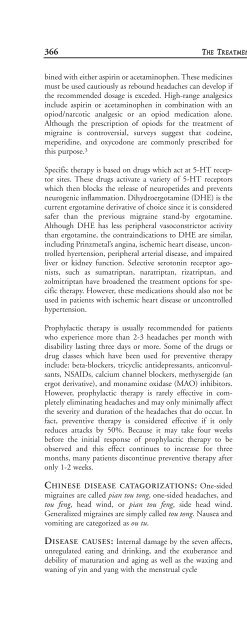The Treatment of Modern Western - Biblio.nhat-nam.ru
The Treatment of Modern Western - Biblio.nhat-nam.ru
The Treatment of Modern Western - Biblio.nhat-nam.ru
- No tags were found...
Create successful ePaper yourself
Turn your PDF publications into a flip-book with our unique Google optimized e-Paper software.
366 THE TREATMENT OF MODERN WESTERN DISEASES WITH CHINESE MEDICINEbined with either aspirin or acetaminophen. <strong>The</strong>se medicinesmust be used cautiously as rebound headaches can develop ifthe recommended dosage is exceded. High-range analgesicsinclude aspirin or acetaminophen in combination with anopiod/narcotic analgesic or an opiod medication alone.Although the prescription <strong>of</strong> opiods for the treatment <strong>of</strong>migraine is controversial, surveys suggest that codeine,meperidine, and oxycodone are commonly prescribed forthis purpose. 3Specific therapy is based on d<strong>ru</strong>gs which act at 5-HT receptorsites. <strong>The</strong>se d<strong>ru</strong>gs activate a variety <strong>of</strong> 5-HT receptorswhich then blocks the release <strong>of</strong> neuropetides and preventsneurogenic inflammation. Dihydroergotamine (DHE) is thecurrent ergotamine derivative <strong>of</strong> choice since it is consideredsafer than the previous migraine stand-by ergotamine.Although DHE has less peripheral vasoconstrictor activitythan ergotamine, the contraindications to DHE are similar,including Prinzmetal’s angina, ischemic heart disease, uncontrolledhyertension, peripheral arterial disease, and impairedliver or kidney function. Selective serotonin receptor agonists,such as sumatriptan, naratriptan, rizatriptan, andzolmitriptan have broadened the treatment options for specifictherapy. However, these medications should also not beused in patients with ischemic heart disease or uncontrolledhypertension.Prophylactic therapy is usually recommended for patientswho experience more than 2-3 headaches per month withdisability lasting three days or more. Some <strong>of</strong> the d<strong>ru</strong>gs ord<strong>ru</strong>g classes which have been used for preventive therapyinclude: beta-blockers, tricyclic antidepressants, anticonvulsants,NSAIDs, calcium channel blockers, methysergide (anergot derivative), and mo<strong>nam</strong>ine oxidase (MAO) inhibitors.However, prophylactic therapy is rarely effective in completelyeliminating headaches and may only minimally affectthe severity and duration <strong>of</strong> the headaches that do occur. Infact, preventive therapy is considered effective if it onlyreduces attacks by 50%. Because it may take four weeksbefore the initial response <strong>of</strong> prophylactic therapy to beobserved and this effect continues to increase for threemonths, many patients discontinue preventive therapy afteronly 1-2 weeks.CHINESE DISEASE CATAGORIZATIONS: One-sidedmigraines are called pian tou tong, one-sided headaches, andtou feng, head wind, or pian tou feng, side head wind.Generalized migraines are simply called tou tong. Nausea andvomiting are categorized as ou tu.DISEASE CAUSES: Internal damage by the seven affects,unregulated eating and drinking, and the exuberance anddebility <strong>of</strong> maturation and aging as well as the waxing andwaning <strong>of</strong> yin and yang with the menst<strong>ru</strong>al cycleDISEASE MECHANISMS: <strong>The</strong> main disease mechanisms<strong>of</strong> migraine headaches all involve the liver. If the liverbecomes depressed due to emotional stress, the qi willbecome stagnant. Because qi is yang and the liver is a yin viscus,either this yang qi will tend to follow the liver channelupward to the eyes and vertex or shift into the shao yangchannel to rise to the sides <strong>of</strong> the head, congesting in andinhibiting the channels and vessels there. If liver depressioncounterflows horizontally, it may assail the stomach, resultingin nausea and vomiting. If liver depression transformsinto heat, heat may flare upward to harass the clear portalsabove. If heat is extreme, it may transform into fire whichmay then engender wind which also tends to counterflowupward. Because the head is a bony box, counterflowingyang qi, heat or fire, and wind, arriving in the head, have littleor no exit. <strong>The</strong>refore, they stagnate and congest, inhibitingthe free flow <strong>of</strong> qi and blood, thus causing pain.Frequently, upward counterflow <strong>of</strong> the liver is associatedwith women’s menst<strong>ru</strong>al cycles. At mid-cycle, yin reaches itsapogee and transforms into yang. Ministerial fire becomesexuberant, and this exuberance may facilitate or aggravateliver depression transforming heat. During the premenst<strong>ru</strong>um,blood is sent down from the heart to the ute<strong>ru</strong>s. If thereis a blood vacuity, A) the sinews’ vessels in the upper bodymay not receive sufficient moistening and nourishment, andB) the liver may not receive its proper nourishment. If theliver fails to be nourished and emolliated, the liver cannotcourse and discharge properly, and yet again liver depressionmay result in upward counterflow or depressive heat mayflare upward. Since the sea <strong>of</strong> blood discharges and is emptyduring and after the menses, blood vacuity or even yin vacuitymay aggravate liver depression or liver yang ascendanthyperactivity during those times as well. As we have seenabove, when the liver becomes depressed, it typically assailsspleen and stomach earth. When it assails the spleen, thespleen becomes damaged and vacuous and fails to engendersufficient blood. <strong>The</strong> spleen may also be damaged by excessivethinking as well as worry and anxiety. Perimenopausally,liver blood and kidney yin are exhausted. So this is also atime when liver depression with upward counterflow, liveryang ascendant hyperactivity, and liver fire and wind are allmore likely.Besides failing to engender sufficient blood, it is also possiblefor spleen vacuity and/or faulty diet to result in internalengenderment <strong>of</strong> phlegm dampness. If this phlegm dampnessobst<strong>ru</strong>cts the qi mechanism in the middle burner, theclear yang may not be upborne and the turbid yin may notbe downborne. Instead, phlegm and dampness may ascend,confounding the clear orifices and blocking the channels andnetwork vessels. Such upward movement by phlegm anddampness is all the more likely if liver qi or internally engenderedfire or wind draft it upwards.
















